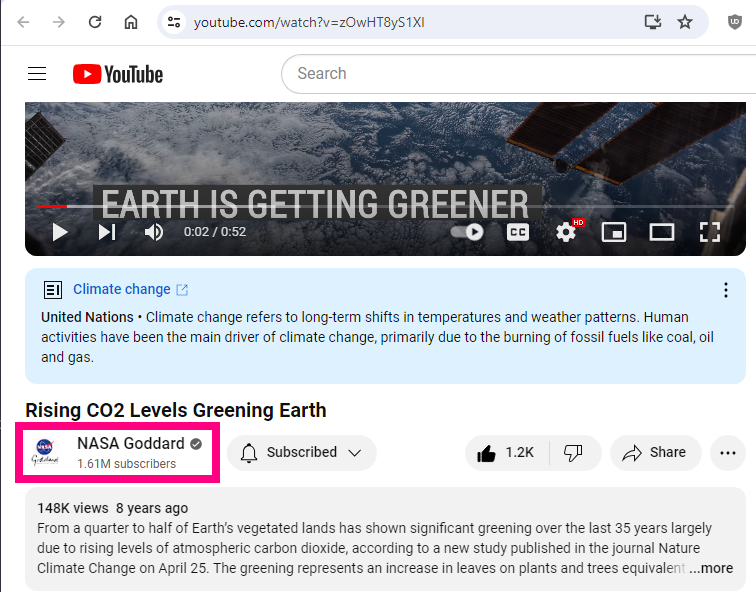The negative “social cost of carbon”
The peer-reviewed evidence is compelling that CO2 emissions are net-beneficial, rather than harmful, and the social cost of carbon is negative. Here are some papers:
- Dayaratna, K.D., McKitrick, R. & Michaels, P.J. (2020). Climate sensitivity, agricultural productivity and the social cost of carbon in FUND. Environ Econ Policy Stud 22, 433–448. doi:10.1007/s10018-020-00263-w
- Uddin S, Löw M, Parvin S, Fitzgerald GJ, Tausz-Posch S, Armstrong R, O'Leary G, Tausz M. (2018). Elevated [CO2] mitigates the effect of surface drought by stimulating root growth to access sub-soil water. PLoS One. 2018 Jun 14;13(6):e0198928. doi:10.1371/journal.pone.0198928
- Fitzgerald GJ, et al. (2016). Elevated atmospheric [CO2] can dramatically increase wheat yields in semi-arid environments and buffer against heat waves. Glob Chang Biol. 2016 Jun;22(6):2269-84. doi:10.1111/gcb.13263.
- Donohue, RJ, Roderick, ML, McVicar, TR, and Farquhar, GD (2013), Impact of CO2 fertilization on maximum foliage cover across the globe's warm, arid environments, Geophys. Res. Lett., 40, 3031–3035, doi:10.1002/grl.50563.
- O'Leary GJ, et al. (2015). Response of wheat growth, grain yield and water use to elevated CO2 under a Free-Air CO2 Enrichment (FACE) experiment and modelling in a semi-arid environment. Glob Chang Biol. 2015 Jul;21(7):2670–2686. doi:10.1111/gcb.12830.
- Loehle, C., Idso, C., & Bently Wigley, T. (2016). Physiological and ecological factors influencing recent trends in United States forest health responses to climate change. Forest Ecology and Management, 363, 179–189. doi:10.1016/j.foreco.2015.12.042.
- Zhu, Z Piao, S, Myneni, RB, et al (2016). Greening of the Earth and its drivers. Nature Climate Change, 6(8), 791–795. doi:10.1038/nclimate3004.
- Gregory, K.B. (2022). Social Cost (Benefit) of Carbon Dioxide from FUND, with Corrected Temperatures, Energy and CO2 Fertilization (v2). (See also.)
- Chun JA, Wang Q, Timlin D, Fleisher D, Reddy V (2011). Effect of elevated carbon dioxide and water stress on gas exchange and water use efficiency in corn. Agricultural and Forest Meteorology, Vol 151, Issue 3, pp 378–384. doi:10.1016/j.agrformet.2010.11.015.
- Taylor, C & Schlenker, W (2021). Environmental Drivers of Agricultural Productivity Growth: CO2 Fertilization of US Field Crops. National Bureau of Economic Research, no. w29320. doi:10.3386/w29320.
- Poorter et al (2021), A meta-analysis of responses of C3 plants to atmospheric CO2: dose-response curves for 85 traits ranging from the molecular to the whole-plant level. New Phytol, 233: 1560-1596. doi:10.1111/nph.17802. Note their Fig. 5i (which I annotated -DAB).
- Lang, P.A. & Gregory, K.B. (2019). Economic Impact of Energy Consumption Change Caused by Global Warming. Energies 2019, 12(18), 3575. doi:10.3390/en12183575.
- Those are all recent papers, but studies measuring the benefits of elevated CO2 go back more than a century. Here's one from 1920:
Gradenwitz A. (1920). Carbonic Acid Gas to Fertilize the Air. Scientific American, 123(22), November 27, 1920, p.549.doi:10.1038/scientificamerican11271920-549
Here's a NASA video about how CO2 is greening the Earth (a very good thing):
https://www.youtube.com/watch?v=zOwHT8yS1XI

https://www.youtube.com/watch?v=zOwHT8yS1XI

Learn more about climate change, here:
https://sealevel.info/learnmore.html
https://sealevel.info/learnmore.html
Twitter card here.
Permalink to this page: https://tinyurl.com/sccneg